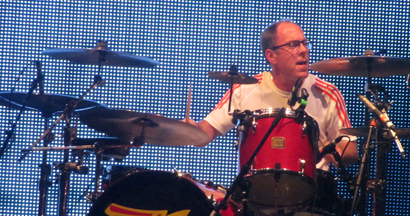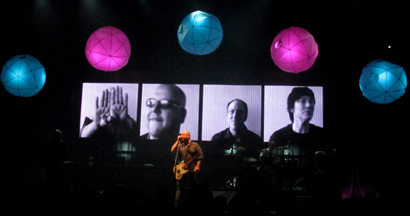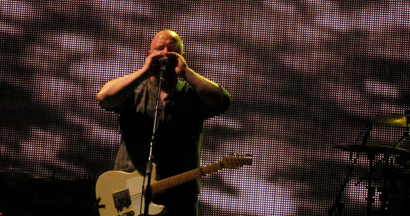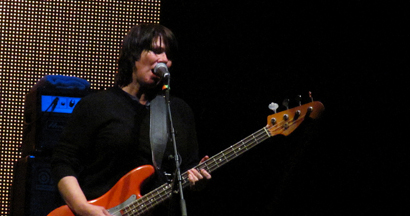The Pixies and the Resurrection of the Album

“These are what we call ‘deep cuts,’ in the album world” – Kim Deal
Twenty-first century music culture is rife with seemingly contradictory realities. For consideration: how can the album be “dying,” as so many have argued, when it simultaneously seems more alive than ever?
The meteoric resurrection of vinyl as a viable commercial form—a conscious choice on the part of the listener to embrace an album start-to-finish—may be the most notable case study in this conundrum, but the rush of bands playing full albums live is just as compelling.
Once a practice mostly reserved for progressive rock icons or cover bands, countless bands are replicating their complete records in concert, from recently-released material to classic, beloved works. Green Day toured American Idiot as a full album, as did the Manic Street Preachers with Journal for Plague Lovers (in Europe, at least). Public Enemy toured It Takes a Nation of Millions. The final leg of Springsteen’s last tour saw the E Street Band playing a different classic record front-to-back each show. The All Tomorrow’s Parties festival organization has a series of shows called “Don’t Look Back,” where bands from the Stooges, to Gang of Four, to Sonic Youth have played beloved albums in full.
And then there’s the Pixies.
In October 2009, to celebrate the 20th anniversary of Doolittle, the band embarked on a worldwide tour playing not only the album in full, but all its b-sides as well, concluding each night with a smattering of hits from their other records. A year and a half later, the tour continues, with a 20-date North American tour heavily focused on Canadian dates.
Including Halifax, Nova Scotia.
That the Pixies actually made it here is surprising for two reasons. The first is that, as local readers will be well aware, we’re not exactly a common touring destination. But last fall, when the band put out a call on their Facebook page asking what cities they might consider playing should they tour Canada again, Haligonians flooded the post with requests, prompting the Facebook admins to reply, “We can certainly add Halifax, Nova Scotia to the list.” That enthusiasm was duly rewarded with the tour’s kickoff show last night.
The second surprise is that the Pixies are actually still together at all. In a decade full of nostalgic reunion tours that usually see the principals have some fun, make some bucks and disappear again, few would have predicted the Pixies to still be touring together a full seven years after burying the hatchet and putting their rather ugly breakup behind them. Maybe there’s a thrill in playing to large, adoring crowds that hasn’t gone away yet. Maybe it’s that when you don’t consider making records—the band has only recorded a single new song since the reunion—there isn’t much to fight about.
Or maybe the money is just too good. After all, Pixies frontman Frank Black was famously quoted last year suggesting that the primary motivation for the reunion shows is money. So it wouldn’t be crazy to think that the decision to tour Doolittle mostly represents a cynical gimmick, an excuse for a band without any new material to hit the road and play to the fans who’ve already done the “reunion tour” show before.
But even if that were true—and the band has more than enough fun on stage that I highly doubt it—who cares? People clearly want to see the Pixies, especially those of us who’ve missed out on both the olden days and the reunion tour so far. And if there’s an album worth celebrating in full, it’s Doolittle, in all its sprawling, messy glory. Writing about Thrush Hermit and the B-52’s last year, I considered that while nostalgia can be cynically abused in a commercial relationship, it can also be leveraged in an honest way to everyone’s mutual benefit. Last night I paid to see the Pixies play classic Pixies songs. As long as they play them well enough to send everyone home happy, then what’s wrong with that?
And mercy, did they play them well.
Aside from the aged faces, the multimedia show and the preferred moniker of the frontman, nothing has changed. Frank Black still has a scream that could shatter eardrums. Kim Deal is still the requisite spokesperson on stage and plays her bass with charm and force to burn. Joey Santiago can still take the simplest riff and make it sound like the cleverest thing you’ve ever heard. And David Lovering still keeps things thunderous from behind the drum kit. Sometimes, when I see one of these reunited bands, I can’t help but feel, “that was good, but no substitute for the ‘back in the day’ that I missed out on.” But the Pixies, in their present form, are so good at playing these songs that one suspects their live experience today may be light years better than it was in their heyday, even if it lacks the “in the moment” sentiment.
But back to the full-album concert. In a way, it’s surprising that this phenomenon has caught on to such a great degree, because one of the most thrilling elements of the live show is, well, surprise. It’s about not knowing what’s coming next, and then, when the first notes of the song hit, feeling the rush of those synapses of realization firing in the brain as you realize which of your favourite tracks is about to blow you away. So there’s something a bit strange about going to a show that recreates an album you’re already intimately familiar with, where you know exactly what’s coming up on the setlist. Though I’ve been to a few of these full-album shows now, I confess that I’ve yet to find any of them as compelling as a show that finds a band cleverly recontextualizing its catalogue and, in the process, creating something unique.
But I suspect that full album shows have become popular, and will continue to be so, for two reasons. The first is that, like with vinyl, they feel like a statement of defiance by bands and fans alike who, resisting the digital age’s ability to separate music from context, hold up the LP as a viable, vibrant art form, one that often presents a greater, more complete and more compelling artistic statement than the individual track. These shows present an argument that these songs, in their original order order, still mean something that can hold true even when translated from the recorded artifact to the live experience.
The second is that these concerts are definitively targeted at devoted fans. Pixies fans who showed up at the Metro Centre last night certainly got their smattering of famous songs, from Doolittle classics like “Here Comes Your Man” and “Debaser” to the four-song hits set that made up the second encore (“Caribou,” “Bone Machine,” “Where is My Mind?” and “Gigantic” to close the show). But they also had to listen to deep album cuts like “Silver” and “No. 13 Baby,” not to mention Doolittle b-sides like “Manta Ray” and “Weird at My School.” These full-album shows reflect a growing separation in music culture between devoted fans and casual listeners, and that increasingly the traditional structures of the music industry—the concert, the album, the merchandise—are becoming the domain of the former. The novelty of hearing songs hardly-played isn’t the sort of thing a casual listener would tolerate.
No, they’re our songs. And last night, the Pixies were our band.










* * * * *

I breathed a huge sigh of relief at the end of Imaginary Cities’ opening set.
Over the past few months I’ve become quite smitten with the Winnipeg two-piece—fleshed out with three other players live—and its debut album, Temporary Resident. It’s a classic example of a record that doesn’t push to be unique, but ends up sounding special all the same. Marti Sarbit’s killer vocals are certainly part of the equation, but it’s also she and her bandmate Rusy Matyas—who’s played as an instrumentalist with the Waking Eyes and the Weakerthans—add a bit of soulful flavour to their folk-based indie rock that gives the entire album a warm, inviting feeling.
I was nervous, though, because they sound nothing like the Pixies. And as good as Halifax crowds can be, I worried whether or not their choice as the Pixies’ opening act on this tour was a bit of a mistake. Thankfully, from where I was standing, the set went over pretty damn good with the crowd, though admittedly there wasn’t a huge audience on-hand by this point in the evening. Credit, to a great degree, the band’s ability to turn up the energy. Even moreso than when I saw them at CMW last month, Cities played their songs louder and with a greater rock sensibility, wisely also choosing to ignore the album’s one or two so-so slower tracks.
Above all else, though, what struck me about Imaginary Cities’ set is that they are way more confident than a band should be at this stage of its career: on its first major tour, opening for alternative rock legends, playing big shows only two months after releasing a debut album. They’ve got stage presence to spare, great control over their sound, and even the guts to play new material. (One new song, “Marry the Sea,” is already a set highlight.) One wonders how good they might be by the time they make it back to Halifax for a proper headlining show.



(From McNutt Against the Music. Follow McNutt on Twitter.)
Related on maisonneuve.org:
—Is Music Losing the Fight For its Own Importance?
—Shock of the Old
—The Death of Record Stores
Subscribe — Follow Maisy on Twitter — Like Maisy on Facebook





